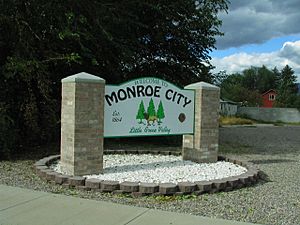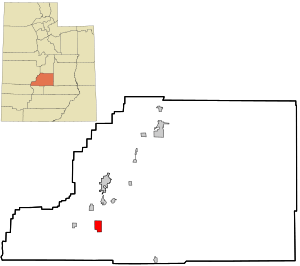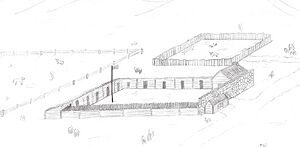Monroe, Utah facts for kids
Quick facts for kids
Monroe
|
||
|---|---|---|

Welcome sign at the northern entrance to Monroe
|
||
|
||
| Nickname(s):
The Little Green Valley
|
||

Location in Sevier County and the state of Utah.
|
||
| Country | United States | |
| State | Utah | |
| County | Sevier | |
| Settled | 1864 | |
| Incorporated | 1920 | |
| Named for | James Monroe | |
| Area | ||
| • Total | 3.57 sq mi (9.25 km2) | |
| • Land | 3.57 sq mi (9.25 km2) | |
| • Water | 0.00 sq mi (0.00 km2) | |
| Elevation | 5,394 ft (1,644 m) | |
| Population
(2010)
|
||
| • Total | 2,256 | |
| • Estimate
(2019)
|
2,358 | |
| • Density | 660.32/sq mi (254.97/km2) | |
| Time zone | UTC-7 (Mountain (MST)) | |
| • Summer (DST) | UTC-6 (MDT) | |
| ZIP code |
84754
|
|
| Area code(s) | 435 | |
| FIPS code | 49-51360 | |
| GNIS feature ID | 1443556 | |
Monroe is a city located in Sevier County, Utah, United States. In 2010, the city had a population of 2,256 people. Monroe is often called "The Little Green Valley" because of the many green fields that surround it.
Contents
Exploring Monroe's Location and Landscape
Monroe is found in a rural part of central Utah. The city covers about 3.5 square miles (9.2 square kilometers) of land. There are mountains to the east and south of Monroe. To the west and north, you will see many farmers' fields.
Natural Hot Springs and Unique Rock Formations
Monroe is famous for its natural hot springs. These springs create special rock deposits called travertine. This happens because of a geothermal system along the Sevier fault. Hot water comes out of the ground at a very warm temperature of 168°F (75.5°C).
On the east side of town, this hot water forms a large travertine mound. It is known as the Monroe Mound. This mound is about one mile long and 200 yards wide. Another hot spring is located about a mile north of town. It is called the Red Hill Hot Springs. This spring also has very hot water and forms a mound. The Red Hill mound is about one-third of a mile wide and has a deep red color.
Understanding Monroe's Population Changes
| Historical population | |||
|---|---|---|---|
| Census | Pop. | %± | |
| 1880 | 744 | — | |
| 1890 | 880 | 18.3% | |
| 1900 | 1,057 | 20.1% | |
| 1910 | 1,227 | 16.1% | |
| 1920 | 1,719 | 40.1% | |
| 1930 | 1,247 | −27.5% | |
| 1940 | 1,292 | 3.6% | |
| 1950 | 1,214 | −6.0% | |
| 1960 | 955 | −21.3% | |
| 1970 | 918 | −3.9% | |
| 1980 | 1,476 | 60.8% | |
| 1990 | 1,472 | −0.3% | |
| 2000 | 1,845 | 25.3% | |
| 2010 | 2,256 | 22.3% | |
| 2019 (est.) | 2,358 | 4.5% | |
| U.S. Decennial Census | |||
In 2000, there were 1,845 people living in Monroe. These people lived in 707 households. About 37% of these households had children under 18 living there. Most households (69.5%) were married couples.
The population of Monroe was spread out by age. About 32% of the people were under 18 years old. The median age in the city was 36 years. This means half the people were younger than 36 and half were older.
A Look at Monroe's Past
Monroe was first settled in late 1863. A small group of explorers, including George Wilson, arrived to find a place to live. They built a simple shelter and stayed through the winter. The first permanent settlers arrived on February 20, 1864. Many of these early settlers were members of the Church of Jesus Christ of Latter-day Saints.
Early Settlement and Name Changes
The town was first called South Bend. This name came from its location near a bend in the Sevier River. Soon after, it was renamed Alma, honoring a prophet from the Book of Mormon. By the end of 1864, about 20 families lived in Alma. They built homes and cleared land for farming.
Challenges with Native Americans
As more settlers moved into the valleys, Native Americans were pushed away from their hunting grounds. This led to conflict. In April 1865, the Black Hawk War began. This war made it hard for settlers to build their farms and homes. Native Americans often tried to take the settlers' animals for food.
To protect themselves, settlers built a fort called Fort Alma in 1865. The fort had homes, a blacksmith shop, and a place for animals. It offered protection for about two years. However, the situation became too dangerous. In April 1867, the settlers of Alma had to leave. Most of them moved to Sanpete County temporarily.
Returning Home and New Beginnings
Settlers tried to return to Alma in 1868 but faced more conflict. They were finally able to come back in March 1871. The next year, they asked for a Post Office. They renamed the city Monroe, in honor of U.S. President James Monroe. By the end of 1872, a telegraph line connected Monroe to the rest of Utah. Monroe became an incorporated town in 1889 and a city in 1921.
The History of Monroe's Hot Springs
In 1882, Thomas Cooper and his wife settled near the hot springs on the east side of town. They built a simple wooden box to collect the hot water for soaking. Around 1905, a larger building was built. It had a dance floor, an indoor swimming pool, and changing rooms. People would travel from far away to enjoy the springs and dance.
In 1930, a man named Farnsworth bought the hot springs. He led a band that played there often. The hot springs were known as "the home of mirth and merriment." They were very popular until about 1950. The springs were brought back to life in the 1970s. In 1995, the name was changed to Mystic Hot Springs.
Monroe Today
Monroe continues to grow with new neighborhoods. It is still known as "The Little Green Valley" because of the many green fields around the city.
Learning in Monroe: Education for All Ages
Monroe is an important center for education in the area. Schools for many nearby towns are located here. These include Monroe Elementary (for grades K-5), South Sevier Middle School (for grades 6-8), and South Sevier High School (for grades 9-12).
Children from nearby towns like Central Valley, Annabella, Elsinore, Joseph, and Sevier come to Monroe for school. Students from the Navajo placement program also attend schools here. They are bused from a dormitory in Richfield.
Recent Event: A Community Incident
On New Year's Eve, December 31, 2023, a group of people at a local church building in Monroe became unwell. It was later found that the heating system had a problem. This caused a gas called carbon monoxide to be released into the building.
Emergency services were called, and the building was checked. High levels of carbon monoxide were found, and everyone was asked to leave. Many people who felt sick were taken to a local hospital for care. The church stated that the heating system would be fixed.
Notable People from Monroe
- Ralph Okerlund — a state senator
See also
 In Spanish: Monroe (Utah) para niños
In Spanish: Monroe (Utah) para niños



